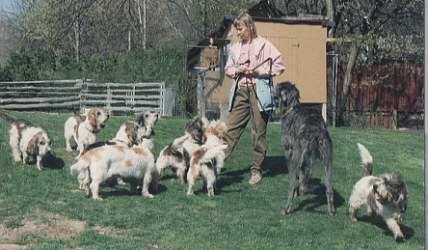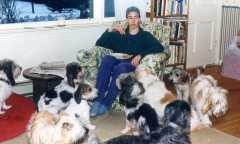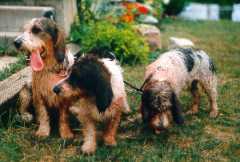
History of the Petit Basset
Griffon Vendeen in Canada
Appearance and Character
Health Concerns
Books available
Conformation Standards CKC &FCI


 To understand the nature of the PBGV you must look to his original purpose
as a hunting hound. These instincts have been bred into him for centuries
so don’t expect to change certain behavior patterns. As they say, "You can’t
change the spots on a leopard". He was bred to work away from the hunter
and make decisions on his own. It is always challenging to work with free-thinkers
like the PBGV. You must have patience. He is always looking for something
exciting to happen. His antics and comical air are the qualities which
captivate us.
To understand the nature of the PBGV you must look to his original purpose
as a hunting hound. These instincts have been bred into him for centuries
so don’t expect to change certain behavior patterns. As they say, "You can’t
change the spots on a leopard". He was bred to work away from the hunter
and make decisions on his own. It is always challenging to work with free-thinkers
like the PBGV. You must have patience. He is always looking for something
exciting to happen. His antics and comical air are the qualities which
captivate us. 
There are a few medical anomalies and ailments that the Petit Basset Griffon Vendéen has been found to suffer from since his arrival to North America. None of these are unique to the Petit Basset Griffon Vendéen breed alone, and are found in the general population of many canine purebreds. All breeders should become familiar with these diseases and take steps towards their prevention to ensure the Petit does not follow the same route as some purebred dogs who have lengthy lists of genetic disorders which keeps getting longer. Hopefully, the future will bring about more thorough genetic tests which will aid in eliminating some of these problems before they are passed on to future generations. In the meantime, some of these disorders will be passed along unknowingly, or knowingly, and it is up to the breeders to take responsibility for each puppy he produces and deal with that puppy in an appropriate manner.
If you are purchasing a PBGV discuss these health issues with the breeder to learn how you can raise your hound with the best intentions towards his well-being. If your Petit is affected by one of these diseases or ailments your breeder would appreciate hearing from you and may also be of assistance to you and your veterinarian. Independent of any Petit Basset Griffon Vendeen Club
an International Database for Petits has been established. You can
help breeders of Petits by filling in information about the Petit that
you already own by going to this site: http://members.aol.com/pbgvhealth/
Information gathered on this site will aid in future breeding decisions
to help produce the healthy pets now and in the future.
Health concerns that PBGV breeders are currently addressing:
Retinal Dysplasia, PPMs, Glaucoma & Cataracts - see "Ophthalmology"
web site below for details. There is now a DNA Test
for Primary Open Angle Glaucoma so all breeding animals can be tested.
Hypothyroidism - see "Canine Health" or "Martindale References"
web site.
Heart Disease - see "Canine Health" or "Martindale References"
web site.
Hip Dysplasia - see "OFA" web site below for full details.
The Institute
for Canine Biology offers charts with regard to Hip Dysplasia and
the PBGV. If you dog is suffering from any type of joint issues here
is site with
some helpful information: http://www.workingdogs.com/doc0039.htm
Article about the inheritance of Hip and Elbow Dysplasia: https://helda.helsinki.fi/bitstream/handle/10138/20742/breeding.pdf?sequence=3
Epilepsy - see ""Canine Health" or "Martindale References" web
site.
To read more about the genetic research into the inheritance of epilepsy
go to http://www.canine-genetics.com/epilepsy.htm
"Neck Pain Syndrome" - Still yet to be specifically diagnosed,
it is similar to necrotizing vasculitis and pain syndromes seen in beagles
and Scottish Deerhounds and other breeds. This syndrome is becoming
documented in the Petit Basset Griffon Vendéen. The cause is still
unknown, often times has a familial link, although not always.
![]() Martindale
References - Virtual Veterinary
Martindale
References - Virtual Veterinary
![]() Local Vets
Local Vets
![]() Canine Epilepsy Network
Canine Epilepsy Network
![]() Canine Ophthalmologist
- an web site of eye anomalies which have ben
Canine Ophthalmologist
- an web site of eye anomalies which have ben
reported
to affect the PBGV such as, PPMs, retinal dysplasia and glaucoma.
![]() Hip Dysplasia - OFA
Hip Dysplasia - OFA
Hip Dysplasia
in the Petit Basset Griffon Vendeen
![]() A Definitive Study of the Petit Basset Griffon Vendéen by Vallerie
Link and Linda Skerritt
A Definitive Study of the Petit Basset Griffon Vendéen by Vallerie
Link and Linda Skerritt
Doral Publishing, Inc, 10451 Palmeras Dr., Suite 225 West, Sun City, AZ
85373
1-800-633-5385 $26.95`
![]() Les Bassets Courants (french) by Maurice Leblanc & John A. Miller
Les Bassets Courants (french) by Maurice Leblanc & John A. Miller
Gerfaut Club, 37 quai des Grands Augustins, 75006 Paris, France
ISBN 2.90119621.7
![]() Les Basset Griffon Vendéen (french) by Claire Dupuis
Les Basset Griffon Vendéen (french) by Claire Dupuis
Editions de Vecchi, 20 rue de la Trémoille, 75008 Paris, France
![]() The Hound and the Hawk "The Art of Medieval Hunting" by John
Cummins
The Hound and the Hawk "The Art of Medieval Hunting" by John
Cummins
Now available
in paperback through internet booksellers.
![]() Judith Bowman Books, Pound Ridge Road, Bedford, NY 10506 U.S.A.
Judith Bowman Books, Pound Ridge Road, Bedford, NY 10506 U.S.A.
- this is a catalogue subscription to hundreds of collectors and
out-of-print
books dealing with all type of angling and hunting as well as many hunting
dog books.
The Canadian Kennel Club Standard (black 1st)
The Federation Cynologique Internationale Standard (brown 2nd)
The Grand Basset Griffon Vendéen
Standard (green 3rd)
The Canadian Kennel Club has the PBGV in Group 2
- Hounds.
The CKC Standard for the PBGV (as of February
1996)
(CKC)Origin and Purpose: Petit Basset Griffon
Vendéen is one of four ancient rough-coated French hounds; an overall
good hunting dog.
General Appearance: A well-balanced, short-legged,
compact hound, rough-coated, with an alert outlook and a lively bearing.
Characteristics: Strong active hound, capable
of a day's hunting, with a good voice, freely used.
Temperament: Happy extrovert, independent,
yet willing to please.
(FCI)General Characteristics:
Small, very active and vigorous. The body only slightly long. Tails
carried proud. Rough hair. Head expressive, ears well turned,
furnished with long hair, attached under the line of the eye, not too long.
Gait: Very unencumbered
and fluid.
(CKC)Size: The measurement at the withers for both male and female should be 13- 1/2 to 15 inches (34-38 cm).
(FCI)Height at withers: From 34 cm to 38 with a tolerance of 1 cm more or less.
(GBGV)Height: 39-43 cm with a 2cm tolerance over the limit for exceptional subjects.
(CKC)Coat: Rough, long without exaggeration, and harsh to the touch with thick undercoat, never silky or woolly Hounds should be shown untrimmed.
(FCI)Coat: Hard, but
not too long, never soft or woolly.
Skin: Quite thick, often
marbled in the tricoloured subjects. No dewlap.
(GBGV)Coat: Hard and not too long, flat, never silky or woolly. The fringes shouldn't be very abundant
(CKC)Colour: White and any combination of Lemon, Orange, Tricolor, or Grizzle markings.
(FCI)Colour: Black with
white spotting (white and black). Black with tan markings (black and
tan). Black with light tan
markings. Fawn with white spotting (white and orange). Fawn
with black mantle and white
spotting (tricolour). Fawn with black overlay. Pale fawn with
black overlay and white
spotting. Pale fawn with black overlay. Traditional names: hare
colour, wolf colour, badger
colour or wild boar colour.
(GBGV)Colour: Unicolour - light or dark fawn is not desirable, hare coloured, white/grey. Bicolour - white & orange, white & black, white & grey, white & red(feu), black & red (feu). Tricolour - white, black & red(feu), white & hare coloured (brown hair with black tips); white/grey & red (feu). Skin: sufficiently thick and often marbled in the tricoloured subjects.
(CKC)Head: Head medium in length, not too wide,
the skull is oval in shape when viewed from the front, well cut away under
the eyes, stop clearly defined. The occipital bone well developed. Muzzle
slightly shorter than from stop to occipital point. Under jaw should be
strong and well developed. Nose should be black, large with wide nostrils.
Eyes surmounted by long eyebrows standing forward,
but not to obscure the eyes. Lips covered with long hair, forming a beard
and mustache. Teeth: Scissor bite preferred, level bite accepted. Eyes:
Large, dark, almond shape, showing no white, with a friendly intelligent
expression. The red of the lower eyelid should not show (haw).
(FCI)Head: Skull: Slightly
domed, not too elongated nor very broad, well chiselled under the eyes,
the
occipital protuberance quite
developed.
Stop: Frontal indentation
defined.
Nose: Prominent, well developed;
nostrils open, black apart from the white and orange
coats where a brown nose
is tolerated.
Muzzle: Much shorter than
that of the Grand Basset but nevertheless very slightly elongated
and straight. Muzzle square
at its end.
Lips: Covered with abundant
moustaches.
Jaws/Teeth: Scissor bite.
Eyes: Quite large with an
intelligent expression, showing no white; the conjunctiva must not
be apparent. The brows surmounting
the eyes standing forward but should not obscure the
eyes. Eyes must be of a
dark colour.
(GBGV)Head: Domed ,long, not too large, well carved out under the eye. Stop well marked. The occipital well developed.
(CKC)Ears: Supple, narrow and fine, covered with long hair folding inwards ending in an oval shape, when pulled forward reaching to the end of the nose. Ears are set on low, in line with the outer corner of the eye.
(FCI)Ears: Leathers: Supple, narrow and fine, covered with long hair and ending in a slight oval, turned inwards and not quite reaching the end of the muzzle. Well set below the level of the eye
(GBGV)Ears: Supple, narrow and fine, covered with long hair and ending in an elongated oval, well turned inwards, reaching at least the end of the nose. Attached below the line of the eye.
(CKC)Neck: Long and strong, slightly arched, without throatiness, carrying the head proudly.
(FCI)NECK : Long and strong;
well muscled; strong at set on; without dewlap, carrying head
proudly.
Forequarters: Shoulders clean and sloping, elbows close to the body. The forelegs straight, a slight crook acceptable. Heavy boned, pasterns strong and slightly sloping. Knuckling over is unacceptable.
(FCI)Forequarters: Overall
view: Bone structure quite strong but in proportion to size.
Shoulders: Clean, oblique,
well attached to the body.
Forearm: Well developed.
Wrist (carpus): Very slightly
defined.
(GBGV)Forequarters: Developed framework. Straight front legs. Thick forearm, the pastern bent. The (wrists) should never touch.
(CKC)Body: Chest deep with prominent sternum, ribs moderately rounded extending well back. Back of medium length, level topline with slight arching over strong loins.
(FCI)Body: Back: Straight,
topline level.
Loin: Muscled.
Croup: Well muscled and
quite wide.
Chest: Not too wide. Rather
deep, reaching the elbow level.
Ribs: Moderately rounded.
(GBGV)Body: Ribs - round. Loins - solid, well filled and slightly arched. Brisket - open, large and deep. Croup - Well opened (flat) and muscled.
(CKC)Hindquarters: Strong and muscular good bend of stifle. Well defined second thigh. Hocks short.
(FCI)Hindquarters: Thigh: Muscled
and only slightly rounded.
Hock: Quite wide, slightly
angulated, never completely straight.
(GBGV)Hindquarters: Strongly muscled but not too rounded. Hocks large, bent and never entirely straight.
(CKC)Feet: Hard, well padded, Nails short and strong.
(FCI)Feet: Not too robust,
hard soled, digits tight, nails strong. Good pigmentation of pads is
desirable.
GBGV)Feet: Big and held tightly together, soles tough, dry, nails strong.
(CKC)Tail (Stern): Of medium length, set on
high, strong at the base, tapering gradually to the tip, well-furnished
with hair, carried proudly like the blade of a saber
(with an air of confidence or cockiness).
(FCI)Tail: Set high, quite
thick at its base, tapering evenly to its tip, rather short, carried sabre
fashion.
(GBGV)Tail: Placed high, thick at the start tapering evenly to the end, (espié - cocky), rather long.
(CKC)Gait: The movement should be free at all paces, with great drive. Front action straight and reaching well forward, hocks should turn neither in nor out.
Major Faults: A dog or bitch measuring more than 1/2 inch (1 cm) either way.
(FCI)Faults: Any departure
from the foregoing points should be considered a fault and the seriousness
with which the fault should
be regarded should be in exact proportion to its degree.
Head: Too short, flat skull,
short muzzle, depigmentation of the nose, lips or eyelids, short
muzzle, pincer bite, light
eye, leathers set high, long, insufficiently turned in or lacking hair.
Body: Too long or too short,
lacking harmony, topline insufficiently firm, slanting croup.
Tail: Deviated stern.
Limbs: Insufficient bone,
lack of angulation, slack in pasterns.
Hair: Not dense enough,
fine hair.
Behaviour: Timid subject.
ELIMINATING FAULTS
– Lack of type.
– Overshot or undershot
mouth.
– Wall eye. Eyes of different
colours (heterochromia).
– Lack of space in the sternal
region; ribs too narrow towards the lower part.
– Kinky tail.
– Crooked or half-crooked
forelegs.
– Woolly coat.
– Self-coloured coat black
or white.
– Important depigmentation.
– Size outside the standard.
– Noticeable invalidating
fault. Anatomical malformation.
– Fearful or aggressive
subject.
N.B. Male animals should
have two apparently normal testicles fully descended into the
scrotum.

|

|

|

|

|

|

|
amblecroft@gmail.com
705-932-1004